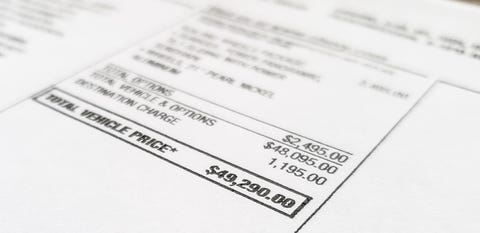It's Not Just You: Cars are Crazy Expensive
Average prices are up 29 percent from 2009.
BY ZACH BOWMAN ZACH BOWMAN
ZACH BOWMANWe finally know how much the 2020 Jeep Gladiator will cost. The truck starts at a shave north of $35,000, delivered. And if that seems insane for a steel-wheeled pickup truck to you, you’re not alone. We see all sorts of new vehicles around here, and increasingly, the first question out of any of our mouths is not, "how much horsepower does it have?" but rather, "What was the sticker?" That’s where the really shocking numbers tend to lie.
It’s not just in our heads, either. Cars have actually gotten more expensive over the past 10 years, and not just by a little bit. Edmunds says that, on average, new cars sold for more than $36,000 in February, up 29 percent from the same month in 2009. Meanwhile, median household income in the US has only risen to around $62,000, an increase of about six percent over the past decade. Even more cringeworthy? Interest rates have also risen in that time period, from an average of five percent to around 6.26 percent. Not only are cars more expensive, but your auto loan will now cost you more money.
The Detroit News says all of this could push more buyers to the used market, where there are plenty of solid vehicles available that won’t cost consumers more than half of their annual household income, but used car prices have crept up right alongside their new-vehicle counterparts, increasing by a staggering 36 percent to $24,499 from $17,980 in 2009.

2020 Jeep Gladiator
FCA US LLC
How has this happened? Cars are nicer than they were 10 years ago. They’re faster, more efficient, safer, quieter, and laden with more tech than ever before, and all of those things cost money. They’re also responses to consumer demands, which is why when you start comparing mid-sized truck MSRPs, you’ll find that they’re all within $1,000 of each other once you check the same option boxes. That doesn’t make them any more affordable, though.
Subprime auto loans, or notes given to borrowers with a FICO score of 620 or below, are also partially to blame for the steady increase in car prices. According to The Financial Times, subprime auto loans represent one of the few consumer credit categories to see a sharp increase over the past year. Easy money means it’s easy to brush off the eye-widening numbers at the bottom of your loan documents.
But as a result, the Federal Reserve Bank says that as of the end of 2018, some seven million Americans were 90 days or more past due on their car loans. That’s an increase of around one million from the year before, and it’s more than ever in the history of the car. The Financial Times says default rates have risen the sharpest among borrowers under 30, followed closely by 30-39 year-olds.
If this feels familiar, it should. The mortgage industry followed a very similar path, one that led to a spectacular economic collapse. That’s less likely to happen here, as auto loans represent a much smaller portion of the country’s economy, around $300 billion, but it’s no less worrying for the industry, and for buyers who just need a solid car that won’t send them down the road to bankruptcy.
No comments:
Post a Comment